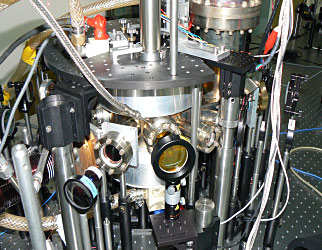Experiments with ultracold atomic Fermi gases influence the disciplines far beyond the limits of atomic physics, since in many cases, the same theoretical models are applicable to the Fermi gas and other Fermi systems:
•neutron stars and nuclei of heavy atoms;
•quark-gluon plasma, which existed during the Big Bang and is produced now in accelerators of elementary particles;
•helium-3 in liquid phases;
•future room-temperature superconductors, whose creation is one of the priorities in the solid-state physics.
 |
Fragment of the experimental setup for preparation
and studies of atomic and molecular gases at ultralow temperatures |
Ultra-cold atomic gas is a unique instrument for verification of these theoretical models, since such an atomic system does not contain uncontrollable defects, and its parameters can be tuned continuously within a wide range. Tunable parameters include interaction, density, spin composition, temperature, and dimensionality.
Fundamentally new phenomena were observed in the Fermi gas of atoms and the Bose gas, specifically: superfluidity with maximally strong (resonant) coupling of fermions; smooth transition from the Fermi statistics to the Bose one; coherent chemical reactions, during which the matter exists in the form of a superposition of the initial and final products of the reaction. These effects were predicted earlier for other systems, but were observed only in experiments with atomic gases under ultralow temperatures.
IAP researchers (A. V. Turlapov, K. A. Martyanov, and V. B. Makhalov) designed a Russia-first experimental setup for preparation of the quantum-degenerate gas of atoms and molecules, in the regimes both of Fermi degeneracy, and of Bose-Einstein condensation. Ultracold gas is prepared in vacuum by the methods of laser trapping and cooling. A Russia-coldest temperature of about 10 nK has been achieved.
For the first time in the world, the two-dimensional gas of fermion atoms has been prepared in the quantum degeneracy state at our institute. The produced two-dimensional Fermi system is a gas consisting of lithium-6 atoms, which is confined in a series of conservative potentials formed by the antinodes of a standing electromagnetic IR-range wave. The gas trapped within each antinode is an isolated two-dimensional system. This was the first time, when the distribution of fermions in any two-dimensional system was observed directly, which opens up new possibilities for diagnostics.
|
|
Photo of clouds of two-dimensional Fermi gas. Each red line corresponds to the two-dimensional cloud observed from
its side |
Gas of Fermi atoms confined within antinodes of an electromagnetic wave. Gas clouds and the intensity of the electromagnetic field are shown in red and purple, respectively. Each cloud is an isolated two-dimensional system |
A decrease in the spatial dimensionality changes radically the physics of phase transitions. For example, the Bose-Einstein condensation is impossible in two-dimensional systems, unlike in three-dimensional ones, though the possibility of formation of the superfluid phase still exists. The two-dimensional Fermi gas of atoms, which is prepared at IAP, can serve as a platform for studying new phenomena. Possibly, one will be able to observe condensation of Cooper pairs to the states with a nonzero momentum for the first time. Some excitations of the two-dimensional system, possibly, will be Majorana fermions, for which the particle and the antiparticle coincide. Superfluidity of the two-dimensional Fermi gas can become an experimental model of high-temperature superconductivity and serve as the basis for validation of the corresponding theories, since the dynamics of electrons in modern high-temperature superconductors is two-dimensional.
The methods of laser cooling and trapping of matter, which are used for preparation of ultracold Fermi and Bose gases of atoms and molecules, can be used in technological applications. For the best precise standards of the time and frequency, the working medium is the gas of atoms under temperatures from tens of nanokelvins to several microkelvins. Such time standards are significant for high-speed data transmission and upgrading of the accuracy of satellite-based navigation systems.
 |
Interference of a string of Bose-Einstein condensates of Li2 molecules. Photos are taken at the initial time moment t = 0 and later moments, in 1.7 and 3.5 ms after the start of interference
|





